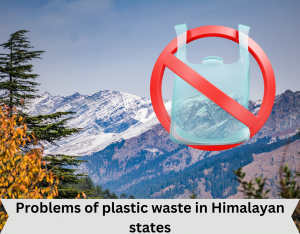ForumIAS announcing GS Foundation Program for UPSC CSE 2025-26 from 27th May. Click Here for more information.
Source-This post on Problems of plastic waste in Himalayan states has been created based on the article “Mountains of plastic are choking the Himalayan States” published in “The Hindu” on 2 March 2024.
UPSC Syllabus–GS Paper-3– Environmental Pollution and Degradation, Environmental Impact Assessment.
News-The article discusses issues of unsustainable plastic waste management practice. Problems of plastic waste in Himalayan states
What is the status of Plastic waste in Himalayan states?
As per The Himalayan Clean up (2018-21) drive and the National Productivity Council of India’s waste and brand audit, there is an increase in plastic waste (especially non-recyclables) in Himalayan states.
For ex-A) The Himalayan Clean up (2022) waste audit results showed that 92.7% of trash was plastic, with 72% of waste being non-recyclable plastic.
B) In Assam, at the Ramsar site of Deepor Beel, Greater adjutant storks are eating the plastic waste in the landfill instead of fish from the wetland.
What are the legal and statutory provisions to deal with plastic pollution?
1) Legal mandates-The government has brought Solid Waste Management Rules (SWM) 2016, Plastic Waste Management (PWM) Rules 2016 and Extended Producer Responsibility (EPR) 2022 to regulate plastic pollution in India.
2) Initiatives by the state government–
A) Himachal Pradesh has a buy back policy for non-recyclable and single-use plastic waste since 2019.
B) Sikkim banned packaged mineral water use from January 2022.
C) Tripura has made policy changes, enacted municipal by-laws and had a State-level task force to eliminate Single Use Plastic
Read more- Plastic Pollution in India: An Overview
What are the reasons for increasing plastic waste in Himalayan States?
1) Urbanization and Changing Consumption Patterns-Rapid and unplanned urbanization, coupled with changing production and consumption patterns, contribute to the plastic waste crisis.
2) Unsustainable Tourism-Unsustainable tourism and a rapid rise in the number of tourists is contributing to an increase of plastic pollution problems in the region.
For ex- the National Green Tribunal has issued notices to Cental Pollution Control Board (CPCB), the Himachal Pradesh State Pollution Control Board and Environment ministry on waste dumping in eco-sensitive areas by tourists and commercial establishments.
3) Unscientific plastic disposal– India has one of the highest mismanaged waste index (MWI), at 98.55%, in the world (after Kenya, Nigeria and Mozambique). This index measures the gap in waste management capacity and plastic consumption.
As per Centre for Science and Environment (CSE), India is recycling (through mechanical recycling) 12% of its plastic waste, burning 20% of its plastic waste and 68% is unaccounted for.
4) Lack of adequate power for local bodies– Under the SWM, PWM and EPR, local bodies are required to perform the task of collection and scientific disposal of plastic waste.
However, only a few States have enacted model by-laws to empower local bodies.
5) Data gaps- There is a need for scientific method of data collection on quantum and quality of plastic waste.
What should be the way forward?
1) Resource Allocation and Support-Adequate resource allocation, infrastructure development, and empowerment of local bodies are crucial for effective waste management, considering the region’s ecological sensitivity.
2)Public Participation and Education-Public engagement through sustained education campaigns and waste segregation initiatives is essential to address the plastic waste crisis.
3) Convergence of Schemes-Convergence of existing schemes like Swachh Bharat Mission, Finance Commission grants, and corporate social responsibility funds can enhance resources for waste management infrastructure and operations.
Question for practice
Why is plastic pollution increasing in Himalayan states despite various statutory and legal measures?





